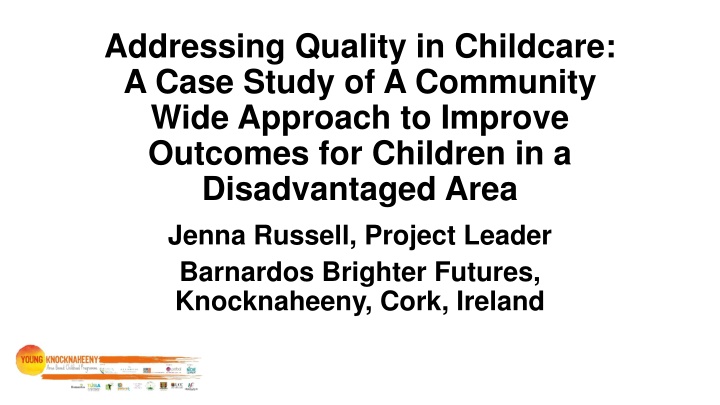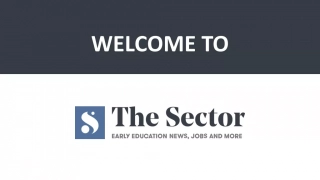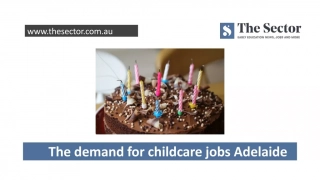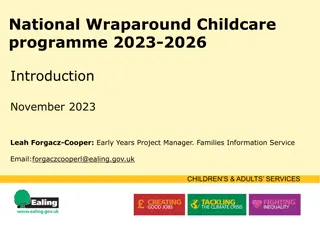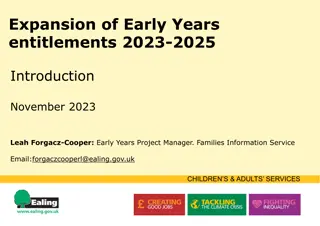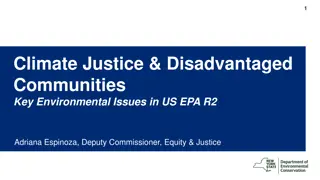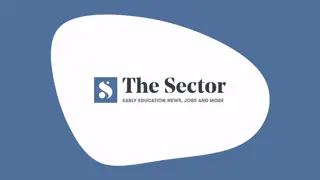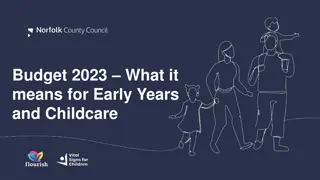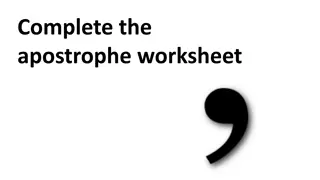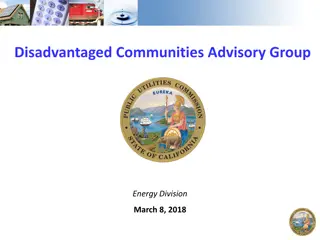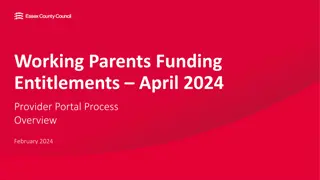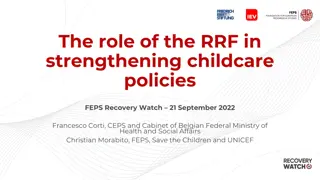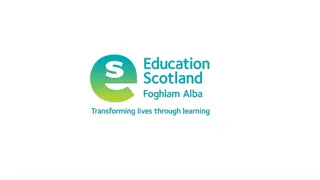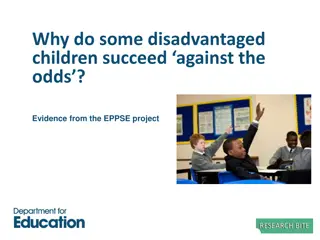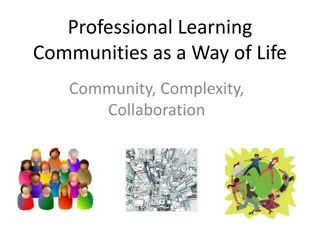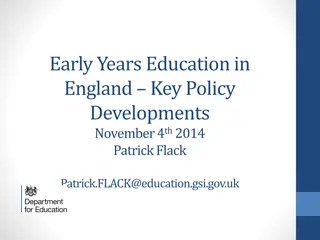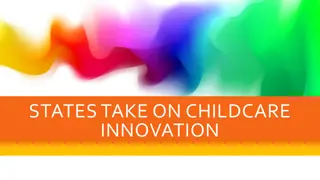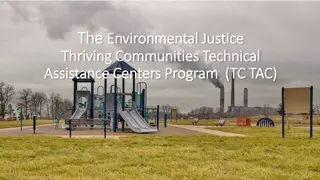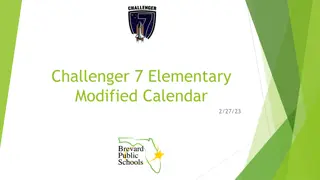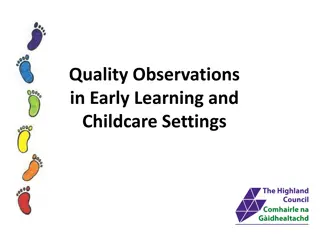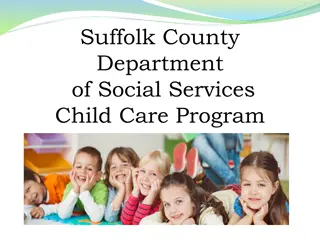Enhancing Childcare Quality in Disadvantaged Communities
This case study explores a community-wide initiative led by Jenna Russell in Cork, Ireland aimed at improving childcare quality in a disadvantaged area. Specifically focusing on Barnardos Brighter Futures program in Knocknaheeny, the approach taken to enhance outcomes for children is analyzed and discussed.
Download Presentation

Please find below an Image/Link to download the presentation.
The content on the website is provided AS IS for your information and personal use only. It may not be sold, licensed, or shared on other websites without obtaining consent from the author.If you encounter any issues during the download, it is possible that the publisher has removed the file from their server.
You are allowed to download the files provided on this website for personal or commercial use, subject to the condition that they are used lawfully. All files are the property of their respective owners.
The content on the website is provided AS IS for your information and personal use only. It may not be sold, licensed, or shared on other websites without obtaining consent from the author.
E N D
Presentation Transcript
Addressing Quality in Childcare: A Case Study of A Community Wide Approach to Improve Outcomes for Children in a Disadvantaged Area Jenna Russell, Project Leader Barnardos Brighter Futures, Knocknaheeny, Cork, Ireland
Location Location Cork city population 119, 230 YK Catchment area population 12,000 children <15yrs 5177 children 0 6 yrs 1155 (Source CSO Census 2011)
Child poverty Poverty, particularly in the early years, impacts on all aspects of a child s life (Duncan et al., 2012). Early childhood development is negatively impacted with lasting effects into adulthood and beyond to the next generation. This intergenerational transmission of disadvantage is more pronounced in liberal economies such as Ireland and the UK than in social democracies (Whelan et al., 2013). In 2015, 11.5% of children in Ireland (aged 0-17) lived in consistent poverty (Barnardos 2016).
Young Knocknaheeny Area Based Childhood Programme (YK) A multi-disciplinary area-based prevention and early intervention partnership which aims to get every child s life off to the best possible start by: Respectfully enhancing the knowledge and skills of all parents and practitioners Strengthening and enhancing all relationships and environments that are important to children Embedding systems and community change to address childhood poverty and support early childhood development
YK Interconnected strategies Speech, Language and Literacy Infant Mental Health and Wellbeing Capacity Building Integration Quality Improvement Early Childhood Care and Education Prosocial Behaviour and Self- Regulation Underpinned by Interdisciplinary Infant Mental Health Framework Supported by an integrated Research and Evaluation
Sample of data sources Small area statistics from 2011Census (Cork City Council) Micra-T - Reading level attainment Standardised testing in IrishPrimary Schools obtained from Primary Schools Data collected by the YK: Strengths and Difficulties Questionnaire (SDQ) teacher- completed (Junior Infants in Primary Schools) Pre-school Language Scale 5th Edition (PSL-5) Clinical testing of Junior Infants by YK Oral Language Officers Early Childhood Environment Rating System (ECERS) external independent assessment of child care settings
YK catchment area demographic profile (Total population 12,000) YK catchment area (% population) 17% Ireland (% population) 44% Post secondary education ( 15 years) Unemployed 15% 30% Renting from Local Authority 8% 38% Ethnicity White Irish 85% 90% Private households with Children 49% 52% Children under 15 21% 21% Families with children under 15: Couples with Children Lone mothers Lone Fathers 78% 21% 1.5% 45% 54% 1.5%
Literacy MICRA-T (Mary Immaculate Reading Attainment Test) Standardised reading test used across Irish primary schools Results presented by 20th percentile (based on the scores of 10,000 pupils in the 2002-2003 school year). Not routinely available for research purposes but aggregated results provided by 3 schools to YK
Micra T Class-based Scores across 3 schools in 2014 (n = 429 students) 50 45 40 35 30 Percentage 25 20 15 10 5 0 1st Class 20th percentile 2nd Class 21st- 40th percentile 3rd Class 4th Class 5th Class 61st- 80th percentile 6th Class 81st- 100th percentile Total 41st- 60th percentile 10
Speech & Language Difficulties PLS5 May/June 2015 (n=117 Junior Infants in 4 schools) 80% 70% 60% 60% 50% 38% 40% 30% 15% 20% 7% 10% 0% Expressive language difficulty only Receptive langauge difficulty only Difficulties in Both categories Total percentage of children with lanugage difficulty
Early Years Service Quality (2015) ECERS Baseline 2015 (n = 14 rooms) 7.0 ECERS Score 1 = inadequate 3 = minimal quality 5 = good 6.0 5.0 4.5 4.0 3.6 4.0 3.4 3.3 3.3 2.7 3.0 2.0 1.0 0.0 CHILDCARE QUALITY AVERAGE SPACE AND FURNITURE PERSONAL CARE ROUTINES LISTENING AND TALKING ACTIVITIES INTERACTION PROGRAM STRUCTURE 12
A Community of Early Years settings driving an ongoing evidence informed quality improvement strategy 35 staff, 350 children Community Montessori preschool (with High/Scope cr che) School Early Start Community settings using play based approach Targeted Early Intervention Centre
Early Years Care and Education High/Scope curriculum training Montessori Masterclasses/site visit/mentoring On Site specialist mentoring Hanen Learning Language and Loving It Environmental enhancement fund Transitions/Supervision focus Increased Parental Engagement and supports Within Aistear/Siolta Framework
Learning to date High/Scope curriculum training with mentor implementation has had the biggest impact on quality improvements in centres Mentor is KEY- trained in High/Scope with practice expertise, able to support the individual, the room and the centre. Time to build a relationship, skilled at naming challenges and what to work on
Schweinhart 2010 To get what we got, you've got to do what we did, - invest in quality practice - and what we did may look expensive. Specifically, highly effective early years programmes must have qualified teachers who learn and use a validated interactive child development curriculum like High/Scope and who develop partnerships with parents
